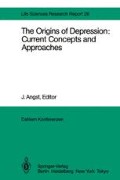Abstract
The term “depression” covers a wide range of phenomena, ranging from normal sadness, grief, and depressive symptoms, to a variety of clinical disorders for which many different terms are used. The group, therefore, started its discussion with an attempt to develop a common terminology for subdividing depressive disorders to be applied in the subsequent discussion of risk factors.
Access this chapter
Tax calculation will be finalised at checkout
Purchases are for personal use only
Preview
Unable to display preview. Download preview PDF.
References
Amenson, C.S., and Lewinsohn, P.M. 1981. An investigation into the observed sex difference in prevalence of unipolar depression. J. Abnormal Psychol. 90: 1–13.
Angst, J. 1966. Zur Aetiologie und Nosologic endogener depressiver Psychosen. Eine genetische klinische Studie. Monographien aus dem Gesamtgebiete der Neurologie und Psychiatric Heft 112. (Abbrev. Engl. Transl.: Foreign Psychiatry, Vol.11, No. 1, 1973).
Angst, J. 1978. The Course of Affective Disorders. II. Typology of Bipolar Manic-Depressive Illness. Arch. Psychiat. Nervenkr. 226: 65– 73.
Bebbington, P.E.; Tennant, C; and Hurry, J. 1981. Adversity and the nature of psychiatric disorder in the community. J. Affect. Dis. 3: 345–366.
Brown, G.W., and Harris, T.O. 1978. Social Origins of Depression. A Study of Psychiatric Disorder in Women. London: Tavistock Publications.
Erlanger-Wyler, M. 1973. Exogene Auslösung bipolarer manischdepressiver Erkrankungen mit spezieller Berücksichtigung der Manien. Dissertation, Zurich University.
Everitt, B.S. 1977. The Analysis of Contingency Tables. London: Chapman and Hall.
Gove, W.R., and Tudor, J.F. 1973. Adult sex roles and mental illness. Am. J. Sociol. 78: 812–835.
Hangnell, O.; Lanke, J.; Rorsman, B.; and Ojesjo, L. 1982. Are we entering an age of melancholy? Depressive illnesses in a prospective epidemiological study over 25 years: the Lundby study, Sweden. Psychol. Med. 12: 279–289.
Hell, D. 1982. Ehen depressiver und schizophrener Menschen. Eine vergleichende Studie an 103 Kranken und ihren Ehepartnern. Monographien aus dem Gesamtgebiet der Psychiatrie, vol.33. BerlinHeidelberg-New York: Springer.
Ilfeld, F.W. 1980. Coping styles of Chicago adults: Description. J. Hum. Stress 6/2: 2–10.
Katschnig, H., and Berner, P. 1982. The Poly-Diagnostic Approach in Psychiatric Research. Paper presented at the International Conference on Diagnosis and Classification of Mental Disorders and Alcohol and Drug Related Problems, Copenhagen, 13-17 April 1982. Geneva: World Health Organization.
Lazarus, R.S. 1966. Psychological Stress and the Coping Process. New York: Mc Graw-Hill.
Mendlewicz, J., and Rainer, J.D. 1977. Adoption study supporting genetic transmission in manic-depressive illness. Nature 268: 327–329.
Parker, G., and Brown, L.B. 1983. Coping behaviors that mediate between life events and depression. Arch. Gen. Psychiat., in press.
Pearlin, L.L, and Schooler, C. 1978. The Structure of Coping. J. Health Soc. Behav. 19: 2–21.
Schulsinger, S.; Kety, S.S.; Rosenthal, D.; and Wender, P.H. 1979. A family study of suicide. In Origin, Prevention and Treatment of Affective Disorders, eds. M. Schou and E. Stromgren, pp. 277–287. London: Academic Press.
Weyrer, S., and Fichter, M. 1983. Psychiatric status and mortality risk among the elderly in the general population. Paper presented at the 3rd European Symposium on Social Psychiatry, Helsinki, 12-15 September 1982. Psychiatria Fennica, in press.
Winokur, G. 1972. Types of depressive illness. Br. J. Psychiat. 120: 265–266.
Editor information
Rights and permissions
Copyright information
© 1983 Berlin, Heidelberg, New York, Tokyo: Springer-Verlag.
About this paper
Cite this paper
Katschnig, H. et al. (1983). Risk Factors. In: Angst, J. (eds) The Origins of Depression: Current Concepts and Approaches. Dahlem Workshop Reports Life Sciences Research Report, vol 26. Springer, Berlin, Heidelberg. https://doi.org/10.1007/978-3-642-69129-4_23
Download citation
DOI: https://doi.org/10.1007/978-3-642-69129-4_23
Publisher Name: Springer, Berlin, Heidelberg
Print ISBN: 978-3-642-69131-7
Online ISBN: 978-3-642-69129-4
eBook Packages: Springer Book Archive

